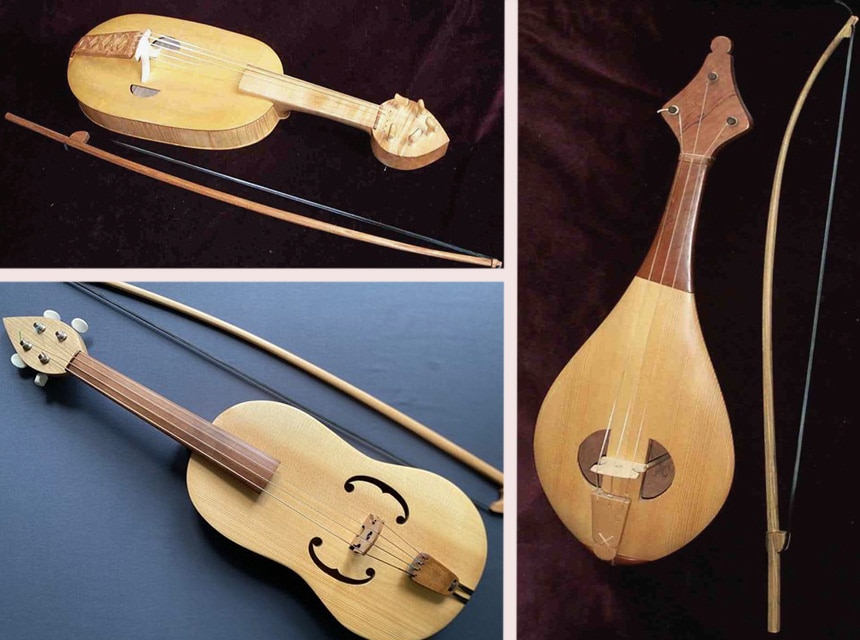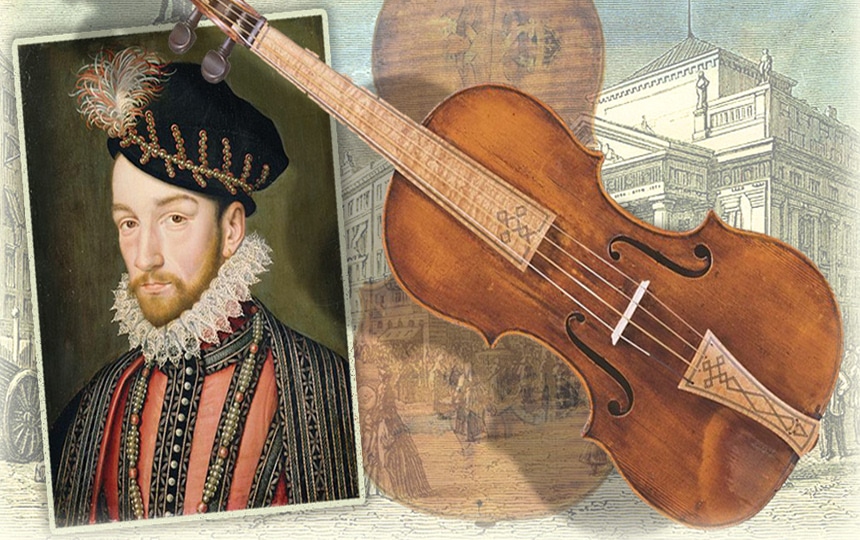The Violin is without a doubt, one of the most famous musical instruments in the world. Anyone familiar with music knows the instrument. It has myriad expressive tones that suit various musical styles. It is popularly known as the undisputed leader of the orchestra. The violin was first discovered in the 16th century but its history can be traced back to as early as the 9th century.
The modern day violin evolved from a variety of other stringed instruments. The Arabian Rabab and the Rebec are known to be the ancestors of Violin. They were popular in Spain and France in the 15th Century right before Antonio Stradivari and Andrea Amati came up with the Violin. In terms of completeness, the Violin is a notch higher than its ancestors. This is mainly because its development was gradual and complex. Read on for some more juicy details on violin history.

The history of the violin can be traced back as early as the 9th century. Its development is likened to the process of evolution as it is gradual and complicated. Most of its stages went undocumented and are therefore indistinct.
The oldest known ancestor of the violin is the ravanastron. It dates back to 5000BCE and was discovered on the island of Sri Lanka. The instrument had a single 22-inch string that spanned 3 octaves. This is an equivalent of the string length and tonal range of the 4 strings combined on a contemporary violin.
So many stringed instruments appeared throughout the ancient world from the Greek kithara to the Chinese erhu. The Rebec which dates back to the 10th century and was discovered in the Middle East is believed to be the first to be held under the chin when being played. It had 3 strings.
History has it that the Rebec is an evolution of the Arabian Rabab and was developed in Spain during the Muslim conquest. It is also believed that it made its way Western Europe during the Muslim conquest.
The French Vielle is one of the earliest evolutions of Rebec. It was popular in the medieval troubadours and had 3 to 5 strings. It had a larger body and was much closer in shape and size to the modern day violin. Its ribs were shaped to allow easier bowing. Later on, the name Vielle was given another instrument; the Vielle a rue commonly known as the hurdy-gurdy.
In the 15th century, 2 bowed instruments emerged in Italy. One; viola da braccio, meaning viola of the arms, had a square shape and was held in the arms. It had 3 strings and was about the same size and shape as the Vielle. The other one was, viola da gamba which means viola for the leg. The 2 instruments were important in the renaissance period but they were quickly replaced by the modern violin.
The violin made its first appearance in Northern Italy in the Brescia area. At this time, Brescia was famous for the school of highly prized string players and makers who invented all the string instruments of the renaissance. The word violin first appeared in Brescian documents in 1530. Other instruments from the first decade of the 15th century did not survive but the violin appears in several paintings from the period.
Jambe de Fer first described the violin to have a fretless appearance and tuning in the Epitome Musicale in 1556. By this time, the instrument had begun to spread throughout Europe. At first, it was used to play dance music but it later became an ensemble instrument for the upper classes. It was played by professional musicians, illiterate folk musicians and servants. At this time, the viol was the real deal in aristocratic circles. It was ideal for contrapuntal music and accompanying vocals.
The violin differed from the viol in many ways. First off, the violin had only 4 strings which were tuned at a 5th from one to the other. The 4 strings had four pitches similar to the ones a viol had on 5 strings. It was also smaller and flatter in design and produced a harsher sound. What’s more, the violin had no frets because the fingers almost touched each other from tone to tone in all parts.
Jambe de Fer depicted viols to be instruments that merchants, gentlemen and other people played to pass time and the violin an instrument used to create dance music. He stated that violins were used for dance music because they were easier to tune, had a sweeter sound and were easier to carry. The violin’s portability was an added advantage especially when used in ceremonies like weddings or mummery.
The 16th Century Italy saw new ideas of sound. The Viola and the cello alongside the violin replaced the gambas and the viols.

Andrea Amati, a famous luthier of the 16th century is commonly believed to be the creator of the modern violin. His first 4-stringed violin is dated 1555. His oldest surviving instrument is from 1560. Between 1542 and 1546 he’s believed to have made a couple of 3-stringed violins.
Legend has it that Amati studied with Gesparo da Salo in Brescia. However, some records show that he was older than Da Salo and was well established in Cremona before he ventured into violins. The Brescian school of luthiers had been around for 50 years before violin making started in Cremona. The Cremona school became prominent after 1630 when Northern Italy was affected by the bubonic plague. The plague got rid of most of the Brescian competition.
Andrea Amati had lots of apprentices. He produced many luthiers including the likes of Bergonzis, Guarneris and Rugeris. Even his own sons followed him into the trade. His grandson, Nicolo Amati was the most famous Amati and he’s the one that trained Antonio stradivus who made over 100 instruments. Modern luthiers imitate his instruments today.
The violin’s design was standardized in the 16th century. History has it that the standardization happened because Andrea Amati has to produce a large number of string instruments ordered by Catherine de Medici in 1560. It is the scale of the commission that led to the 4 string being fixed and the f-curve being popularized as part of the violin’s design.
However, the dimensions and shape of the f-curve were not standardized until the 19th century. It is believed that the notches were meant to be a pointer to where the bridge should be installed. The remaining s-curves therefore paved way to the f-curve. The bridge height, the neck’s length and angle, and the fingerboard’s length are other parts of the violin that were standardized in the 19th century.
The fingerboard was lengthened to allow the player to play the highest notes. It was also tilted to allow more volume. The neck was lengthened by 1 centimeter to enable the rising of pitch. The bass bar was also made heavier to enable greater string tension. Classical luthiers would attach the neck to the violin by nailing and gluing it to upper block of the body before attaching it to the soundboard. Modern luthiers mortise the neck to the violin’s body once they are done assembling it.
Amati built his violins with a mould therefore his measurements increasingly became precise. He created a more vaulted shape for the body as opposed to the flat soundboards of the violin’s predecessors.
By the late 18th century the violin was incredibly popular. It rose from being an instrument of the lower classes to being an integral instrument in the orchestra. Famous composers like Monteverdi started writing for the instrument. Makers started using varnish developed to dry quicker and it had an impact on the quality of the instruments produced. The quality of the wood used to make the instruments declined because of lack of purity of water. All the substances dissolved in the modern water penetrated the wood permanently.
It is because of the reduced quality of the modern instruments that make the violins of the early Italian master pricey. They are well-regarded and expensive. You’d have to part with millions for a Stradivarius violin.
In the 19th century millions of violins were made all over Europe, from France, Italy, Germany and Bohemia to Austria and parts of Czech Republic.
The modern violin is not entirely Italians’ work. The modern bow’s dimensions were standardized by Francois Tourte in 1786. He was a Frenchman. He made changes to the bow’s tension and balance to allow for more intensive bowing techniques. The chin rest was introduced by the German Louis Spohr in 1820. The electric violin was created by William Bartley and Marshall Moss in 1938. There are other recent inventions meant for modern use like the Romanian Stroh. It used amplification like the one a gramophone uses for a higher volume.
The violin has earned its way to the top as an integral instrument because of its ability to evoke any type of mood from somber and sad to sweet and playful. Currently, the concertmaster of an orchestra is a first chair violinist. She/he tunes the orchestra, plays the violin solos and coordinated the harmonious playing of other strings.
Here are a few fun facts about the violin that enrich its reputation;
Anyone who knows a little about music knows or has heard of the violin. It is an integral instrument in many musical settings because it has the ability to evoke different moods. It also has multiple expressive tones that suit various musical styles. Just how much do you know about the violin’s history? We have given details about its origins and evolution.
When you take violin lessons, you only learn the basic stuff about different types of violins before you begin learning how to play. You can invest in the most famous violin history book The Amadeus Book of the Violin to learn about the bass, Cremona, Steiner or Nippon violin history. It traces the history, repertoire and construction of the violin with unmatched thoroughness. The Stradivari’s Genius is another highly acclaimed option. You can get it if you are interested in the Stradivarius violin history.